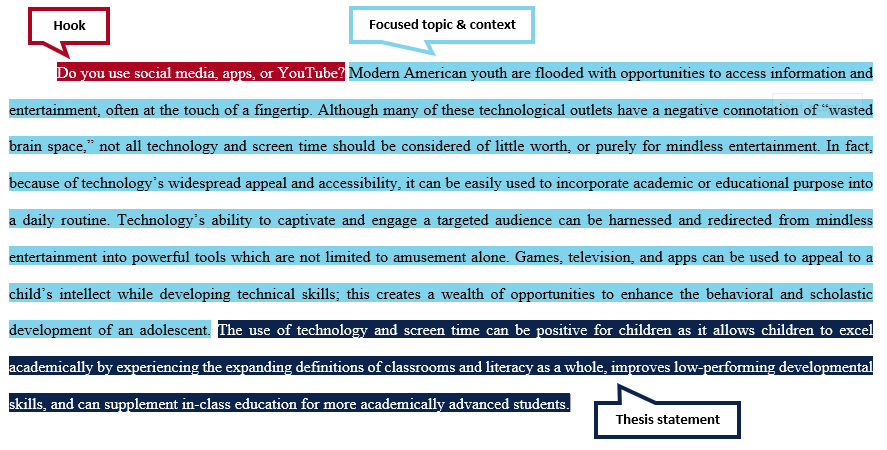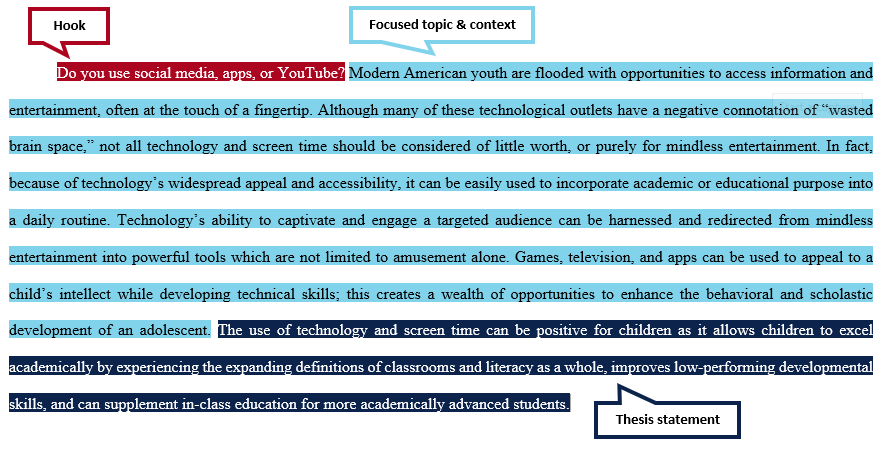How to Write Introduction Paragraph – Learn how to write an introduction for any essay and improve your grade. This page contains various introduction sentence examples, including cute and funny introductions, and common and uncommon topics.
Table of Contents
Introductions
An introduction is typically the first paragraph of your paper. The goal of your introduction is to let your reader know what he or she can expect from your paper. While there is no one formula for writing a good introduction, in general, an introduction should do the following:
- Attract the Reader’s AttentionBegin your introduction with a “hook” that grabs your reader’s attention and introduces the general topic. Here are some suggestions on how to create a “hook”:
- State an interesting fact or statistic about your topic
- Ask a rhetorical question
- Reveal a common misconception about your topic
- Set the scene of your story: who, when, where, what, why, how?
- Share an anecdote (a humorous short story) that captures your topic
- State Your Focused TopicAfter your “hook”, write a sentence or two about the specific focus of your paper. What is your paper about? Why is this topic important? This part of the introduction can include background information on your topic that helps to establish its context.
- State your ThesisFinally, include your thesis statement. The kind of thesis you include depends on the type of paper you are writing, but, in general, your thesis should include:
- your specific topic
- your main point about that topic
- the points of discussion you will include in your paper
Sample Introduction

How to Write Introduction Paragraph
Step 1: Hook your reader
Your first sentence sets the tone for the whole essay, so spend some time on writing an effective hook.
Avoid long, dense sentences—start with something clear, concise and catchy that will spark your reader’s curiosity.
The hook should lead the reader into your essay, giving a sense of the topic you’re writing about and why it’s interesting. Avoid overly broad claims or plain statements of fact.
Examples: Writing a good hook
Take a look at these examples of weak hooks and learn how to improve them.
- Braille was an extremely important invention.
- The invention of Braille was a major turning point in the history of disability.
The first sentence is a dry fact; the second sentence is more interesting, making a bold claim about exactly why the topic is important.
- The internet is defined as “a global computer network providing a variety of information and communication facilities.”
- The spread of the internet has had a world-changing effect, not least on the world of education.
Avoid using a dictionary definition as your hook, especially if it’s an obvious term that everyone knows. The improved example here is still broad, but it gives us a much clearer sense of what the essay will be about.
- Mary Shelley’s Frankenstein is a famous book from the nineteenth century.
- Mary Shelley’s Frankenstein is often read as a crude cautionary tale about the dangers of scientific advancement.
Instead of just stating a fact that the reader already knows, the improved hook here tells us about the mainstream interpretation of the book, implying that this essay will offer a different interpretation.
Step 2: Give background information
Next, give your reader the context they need to understand your topic and argument. Depending on the subject of your essay, this might include:
- Historical, geographical, or social context
- An outline of the debate you’re addressing
- A summary of relevant theories or research about the topic
- Definitions of key terms
The information here should be broad but clearly focused and relevant to your argument.
Don’t give too much detail—you can mention points that you will return to later, but save your evidence and interpretation for the main body of the essay.
How much space you need for background depends on your topic and the scope of your essay. In our Braille example, we take a few sentences to introduce the topic and sketch the social context that the essay will address:Example: Background informationThe writing system of raised dots used by blind and visually impaired people was developed by Louis Braille in nineteenth-century France. In a society that did not value disabled people in general, blindness was particularly stigmatized, and lack of access to reading and writing was a significant barrier to social participation. The idea of tactile reading was not entirely new, but existing methods based on sighted systems were difficult to learn and use.
What can proofreading do for your paper?
Scribbr editors not only correct grammar and spelling mistakes, but also strengthen your writing by making sure your paper is free of vague language, redundant words and awkward phrasing.


Step 3: Present your thesis statement
Now it’s time to narrow your focus and show exactly what you want to say about the topic. This is your thesis statement—a sentence or two that sums up your overall argument.
This is the most important part of your introduction. A good thesis isn’t just a statement of fact, but a claim that requires evidence and explanation.
The goal is to clearly convey your own position in a debate or your central point about a topic.Example: Thesis statementAs the first writing system designed for blind people’s needs, Braille was a groundbreaking new accessibility tool. It not only provided practical benefits, but also helped change the cultural status of blindness.
Step 4: Map your essay’s structure
Particularly in longer essays, it’s helpful to end the introduction by signposting what will be covered in each part. Keep it concise and give your reader a clear sense of the direction your argument will take.Example: SignpostingThis essay begins by discussing the situation of blind people in nineteenth-century Europe. It then describes the invention of Braille and the gradual process of its acceptance within blind education. Subsequently, it explores the wide-ranging effects of this invention on blind people’s social and cultural lives.
Step 5: Check and revise
As you research and write, your argument might change focus or direction as you learn more.
For this reason, it’s often a good idea to wait until later in the writing process before you write the introduction paragraph—it can even be the very last thing you write.
When you’ve finished writing the essay body and conclusion, you should return to the introduction and check that it matches the content of the essay.
It’s especially important to make sure your thesis statement accurately represents what you do in the essay. If your argument has gone in a different direction than planned, tweak your thesis statement to match what you actually say.
You can use the checklist below to make sure your introduction does everything it’s supposed to.
Checklist: Essay introduction
0 / 5
- My first sentence is engaging and relevant.
- I have introduced the topic with necessary background information.
- I have defined any important terms.
- My thesis statement clearly presents my main point or argument.
- Everything in the introduction is relevant to the main body of the essay.
Conclusion
Writing the introductory paragraph for an essay or other assignment can be one of the hardest parts of the writing process. The introduction effectively serves as the doorway to the rest of your paper and influences readers to continue reading. It grabs their attention and piques their interest; if it is well-written, it could even make them curious enough to turn your essay into a research project. It is no small feat, and it all begins with the introduction sentence examples you decide to use in your paper.
